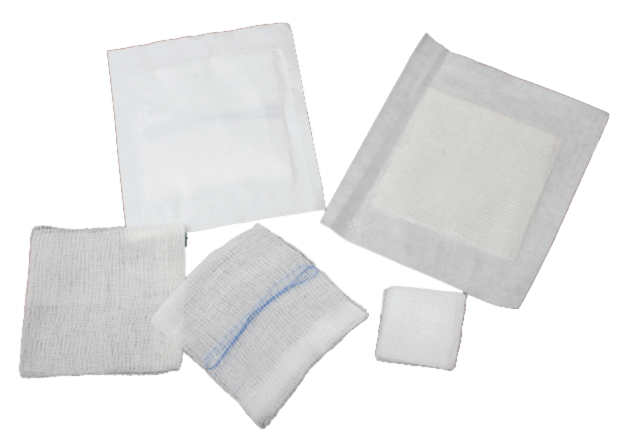
Gauze Sponges (Sterile)
Sterile Gauze sponges are commonly used in medicine and surgery. They are ordinarily made of gauze and are used to absorb blood and other fluids as well as clean wounds. Some gauze sponges have an adhesive backing that allows them to stay on the skin, while others do not.
A sterile gauze sponge is a small, absorbent pad that is used for cleaning wounds or applying medication to the skin. Sterile gauze sponges are usually made of cotton or other absorbent materials and are available in various sizes. Sterile gauze sponges are typically used to cleanse wounds, remove debris, and apply ointments or other medications. They may also be used to stop bleeding by applying pressure to the wound. Sterile gauze sponges are often used in conjunction with other medical supplies, such as bandages, tape, and sterile gloves.
There are many types of sterile gauze sponges, each with their own benefits and uses. The most common type of sterile gauze sponge is the cotton gauze sponge. Cotton gauze sponges are absorbent and work well for cleaning wounds or applying ointments. They are also soft and gentle on the skin, making them ideal for use on sensitive areas. Another type of sterile gauze sponge is the rayon gauze sponge. Rayon gauze sponges are more absorbent than cotton gauze sponges and can be used for heavier wound-cleaning tasks. They are also less likely to cause allergic reactions in people with sensitive skin. Polyester gauze sponges are another option for wound care. Polyester gauze sponges are less absorbent than rayon or cotton gauze sponges but they are more durable and can be reused multiple times. Polyester gauze sponges are also hypoallergenic, making them a good choice for people with sensitive skin.
There are many different types of gauze sponges, each with their own specific uses. Sterile gauze sponges are often used in hospitals and other medical settings because they help to reduce the risk of infection. However, there are also some potential disadvantages to using sterile gauze sponges. One of the main advantages of using sterile gauze sponges is that they can help to reduce the risk of infection. This is particularly important in hospital settings, where patients may be vulnerable to developing infections. Sterile gauze sponges can also be used to clean wounds and dressings, which can further help to reduce the risk of infection. However, there are also some potential disadvantages to using sterile gauze sponges. One of the main disadvantages is that they can be more expensive than other types of gauze sponges. Additionally, sterile gauze sponges may not be as absorbent as other types of gauze sponges, which means they may need to be changed more frequently.
There are many different types of sterile gauze sponges available on the market today. Here is a guide on how to use them correctly:
1. When using a sterile gauze sponge, it is important to make sure that your hands are clean. Wash them thoroughly with soap and water or use an alcohol-based hand sanitizer.
2. Open the package containing the sterile gauze sponge and remove one from the pack.
3. Apply pressure to the area you wish to clean with the gauze sponge. Hold for several seconds before release. Repeat this process until the area is clean.
4. When finished, dispose of the used gauze sponge in a trash can or container marked for medical waste.
If you're looking for alternatives to sterile gauze sponges, there are a few options available. One option is to use pre-moistened wipes, which can be found at most drugstores. Another option is to use a clean washcloth or cotton ball soaked in warm water. If you're looking for something a little more absorbent than sterile gauze sponges, you can try using cotton balls or pads. You can also find disposable pads that are specifically designed for wound care at most drugstores. Finally, if you're looking for an alternative to using gauze altogether, consider using tape instead. Tape is less likely to irritate the skin and can be easily removed when necessary.